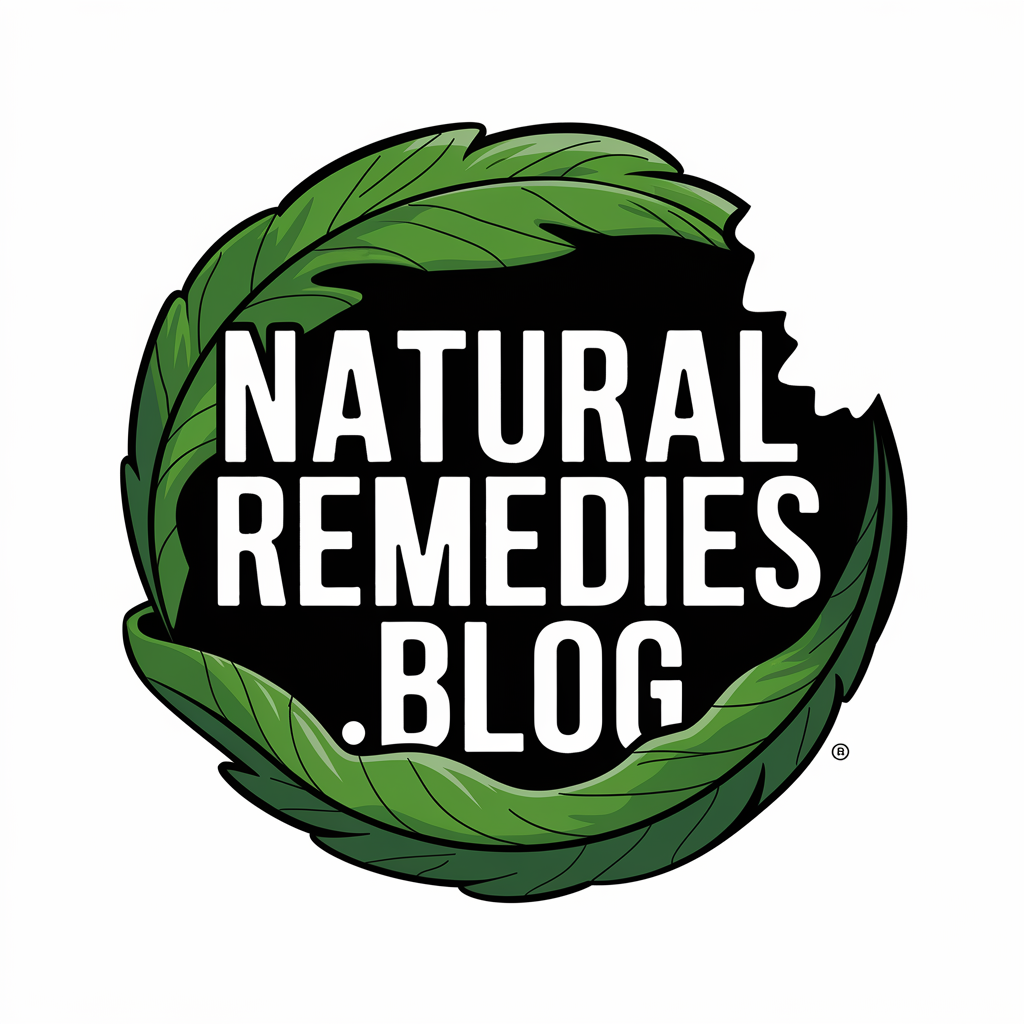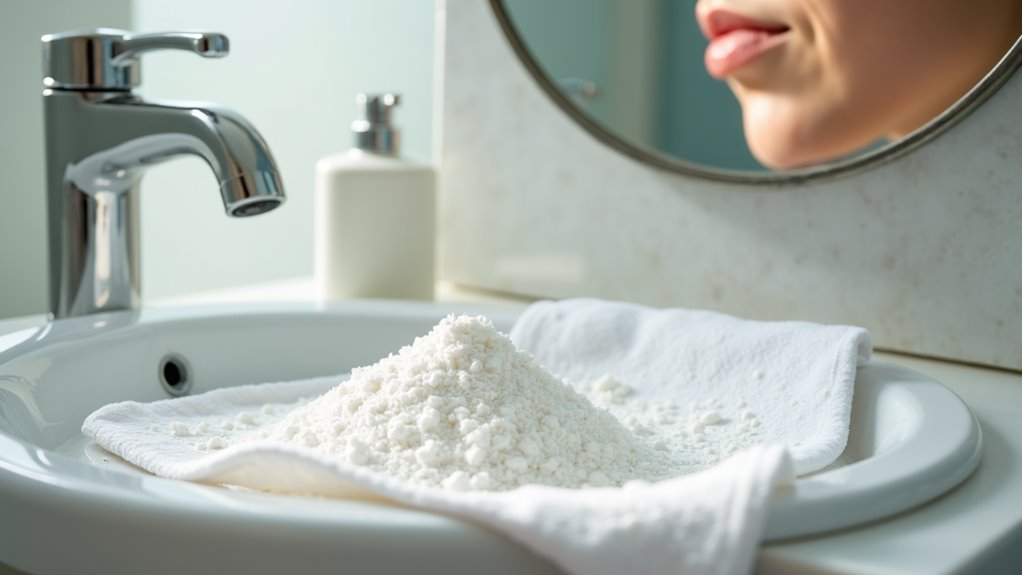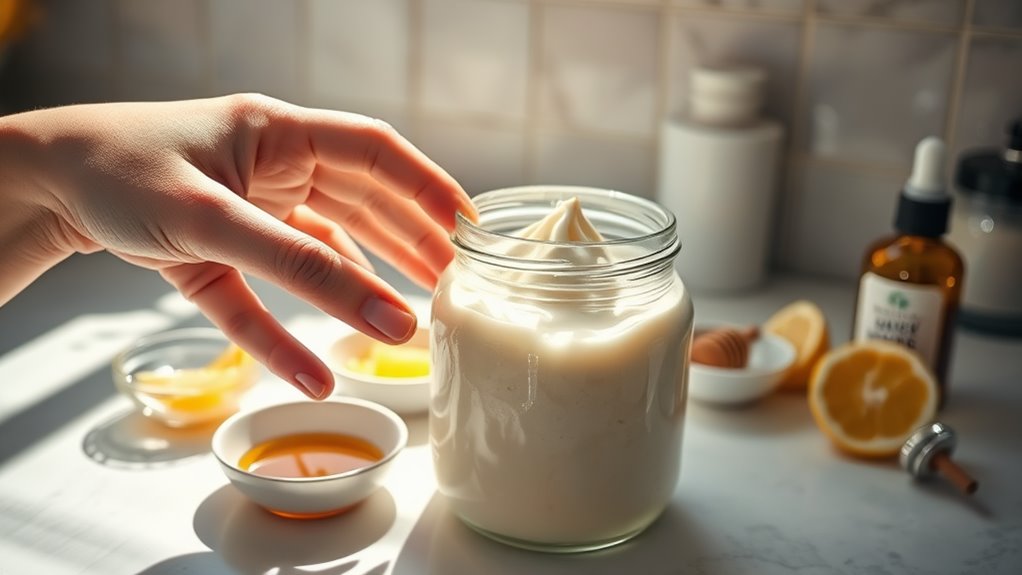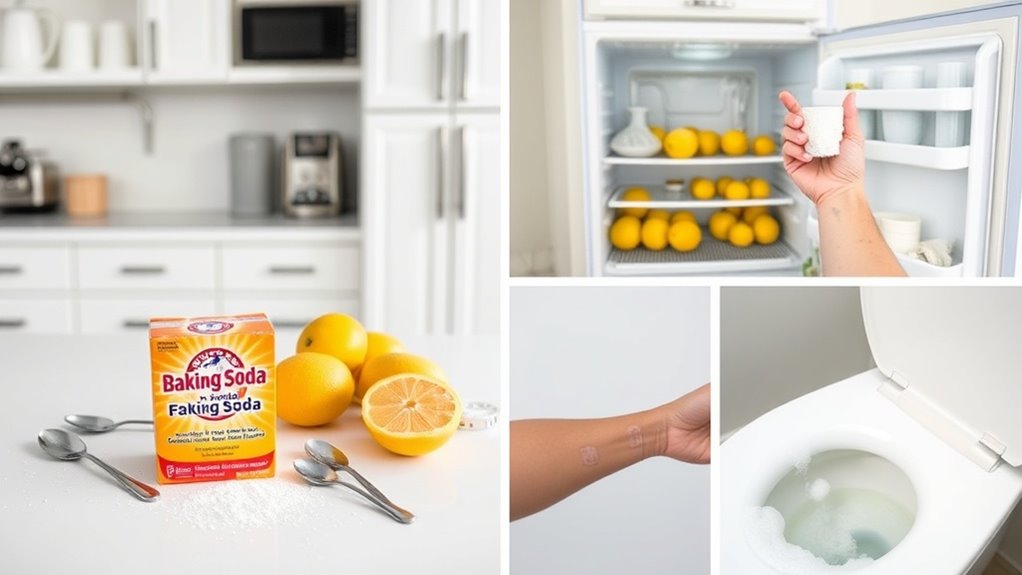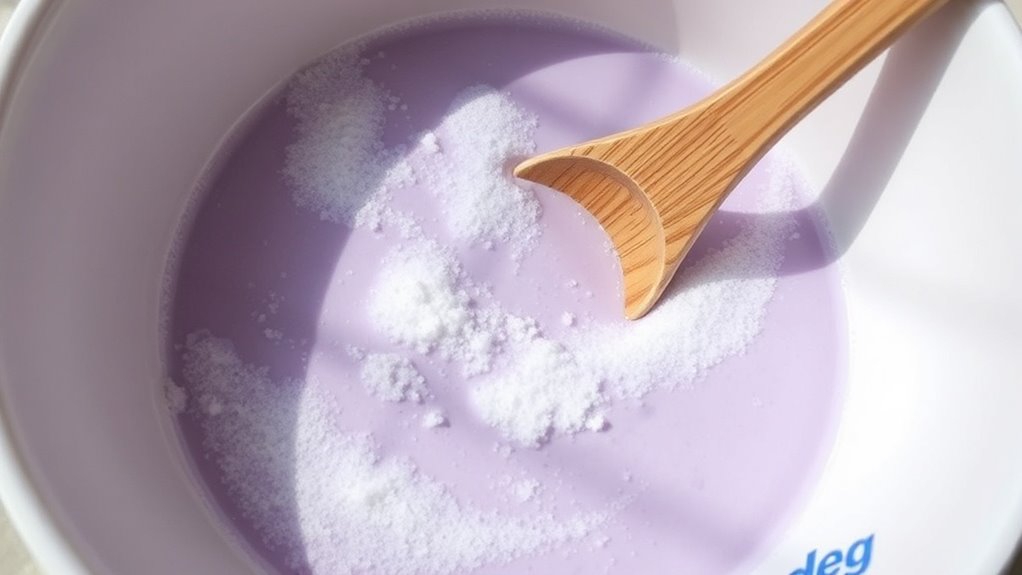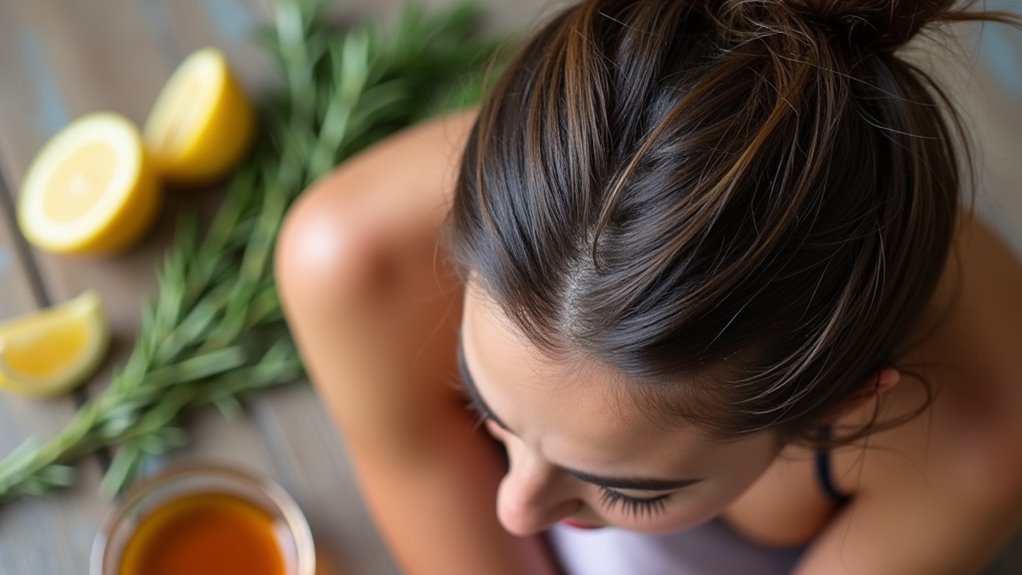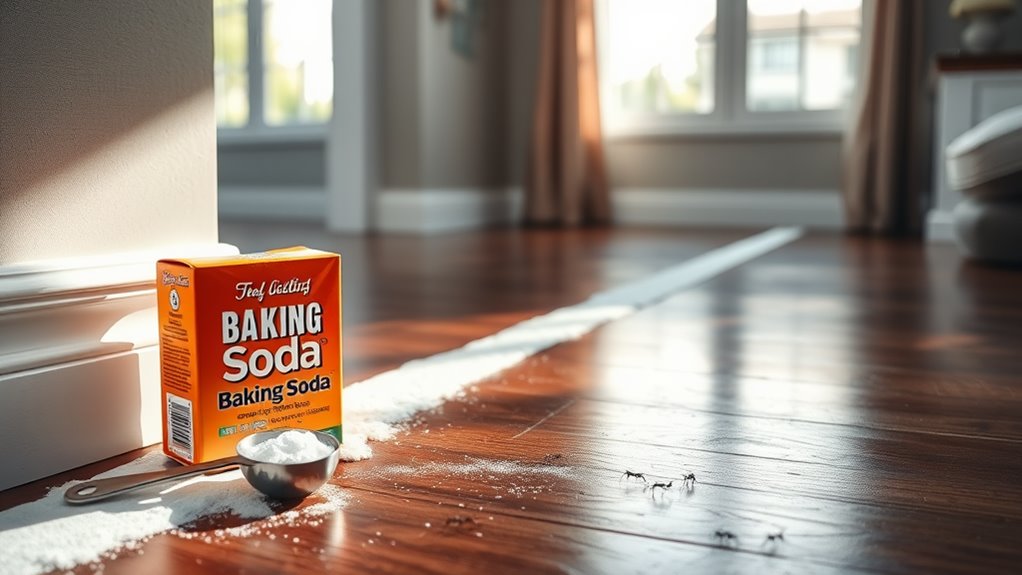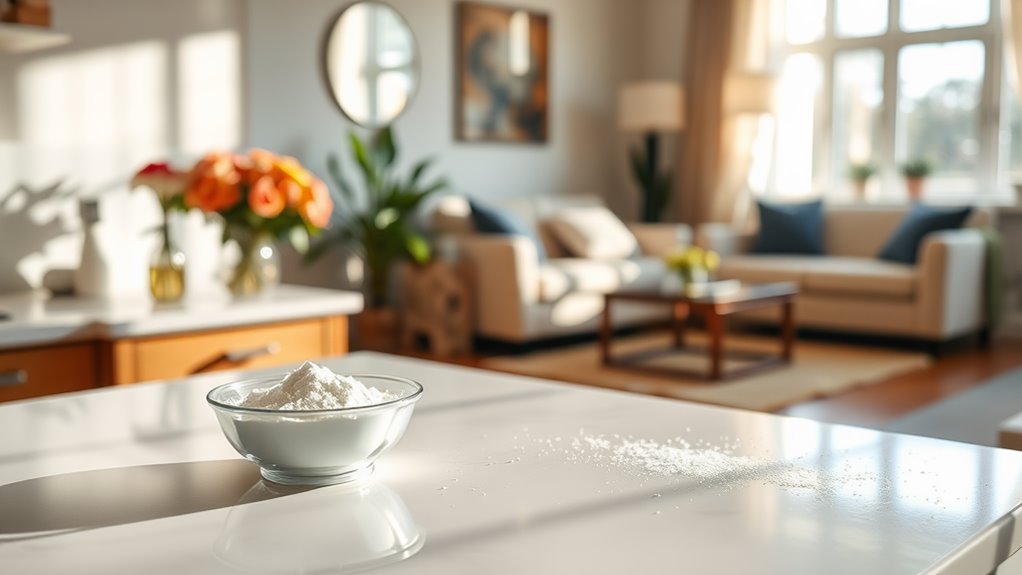My Experience With Using Baking Soda for Acne
You’ll need to approach baking soda face treatments with caution due to their strong alkaline properties. While some users report improvements in acne and skin texture after 3-4 weeks of consistent use, the high pH level (9.0) can disrupt your skin’s natural acid mantle. Limit applications to 1-2 times weekly, always patch test first, and monitor for signs of irritation. Understanding the proper mixing ratio and application technique makes the difference between potential benefits and skin damage.
Why I Turned to Baking Soda
After struggling with persistent acne for three years and trying numerous over-the-counter treatments, I began researching alternative remedies that wouldn’t irritate my sensitive skin.
Through extensive online research, I discovered that baking soda uses extend beyond kitchen applications. Its naturally alkaline properties and mild exfoliating qualities caught my attention, especially given its reputation as a gentle, cost-effective solution.
Clinical studies suggested its potential antimicrobial effects, while user testimonials highlighted its ability to balance skin pH levels.
The readily available nature of baking soda, combined with its simple application process, made it an appealing option for my acne concerns.
The crystalline structure of baking soda provides natural exfoliation by gently removing dead skin cells without harsh abrasives.
My Initial Skin Condition
Three distinct types of acne affected my skin when I first considered using baking soda: inflammatory papules across my cheeks, blackheads concentrated in my T-zone, and occasional deep cystic lesions along my jawline. Balancing pH levels was crucial since baking soda helps neutralize both acidic and alkaline substances on the skin. Previous treatments, including benzoyl peroxide and salicylic acid, provided only temporary relief. My skin’s pH measured 6.5, indicating slight acidity, while sensitivity tests showed reactions to common preservatives in commercial products, leading me to seek alternative solutions.
| Skin Area | Acne Description |
|---|---|
| Cheeks | Red, inflamed papules |
| T-zone | Open comedones |
| Jawline | Painful cystic lesions |
| Forehead | Minor whiteheads |
| Chin | Mixed breakouts |
Research and Safety Precautions
Before considering baking soda as an acne treatment, I conducted extensive research through peer-reviewed dermatological journals and consulted two board-certified dermatologists. The findings revealed significant risks: baking soda’s pH level (9.0) can disrupt skin’s natural acid mantle (pH 4.5-5.5), potentially causing irritation, inflammation, and increased bacterial growth.
You’ll need to perform a patch test 24 hours before facial application. Mix one part baking soda with three parts water, apply to inner arm, and monitor for adverse reactions. If redness, itching, or burning occurs, discontinue use immediately.
Those with sensitive skin or existing skin conditions should avoid this treatment entirely.
My Baking Soda Treatment Recipe
To create an effective baking soda acne treatment, you’ll need pure baking soda, filtered water, and a clean mixing bowl.
Mix one part baking soda with two parts water until you’ve formed a smooth, spreadable paste that isn’t too runny or too thick.
Before applying the mixture to your entire face, it’s essential to patch-test on a small area of skin and limit treatment sessions to once or twice per week to prevent irritation.
The natural antibacterial properties of baking soda help fight acne-causing bacteria while removing dead skin cells.
Simple Three-Step Process
Following this simple three-step process will help you create an effective baking soda treatment for acne-prone skin. While maintaining precise measurements and timing ensures optimal results, you’ll need to monitor your skin’s response carefully.
| Step | Action |
|---|---|
| 1 | Mix 2 tsp baking soda with 1 tsp water |
| 2 | Apply paste gently in circular motions |
| 3 | Leave on for 1-2 minutes, then rinse |
| 4 | Follow with moisturizer |
You’ll want to perform this treatment no more than twice weekly to prevent skin irritation. If you experience redness or sensitivity, reduce frequency or discontinue use. Remember to patch test before full application.
Safety Tips and Ingredients
When preparing a baking soda treatment for acne, proper ingredient selection and safety protocols are essential for optimal results. Use only pure, aluminum-free baking soda and filtered water.
You’ll need 1 tablespoon of baking soda and 1 tablespoon of water to create an effective paste.
Before applying the mixture, perform a patch test on your inner arm to check for adverse reactions. If you experience redness, itching, or irritation, discontinue use immediately.
Don’t leave the paste on for more than 2 minutes, and never use it more than twice weekly. Always moisturize after treatment to prevent skin dryness.
Step-by-Step Application Process
You’ll begin by creating a smooth paste with baking soda and water until it reaches a toothpaste-like consistency.
Apply the mixture gently to your affected areas using circular motions, being careful not to scrub too vigorously on inflamed spots.
After letting the treatment sit for 1-2 minutes, rinse thoroughly with lukewarm water and pat your skin dry with a clean towel.
Mixing the Paste
Before beginning the baking soda application process, it’s essential to create the right consistency of paste using precise measurements. You’ll need to combine baking soda with filtered water in specific ratios to achieve optimal results.
| Skin Type | Baking Soda | Water |
|---|---|---|
| Oily | 2 tsp | 1 tsp |
| Normal | 1.5 tsp | 1 tsp |
| Sensitive | 1 tsp | 1 tsp |
Mix the ingredients in a clean, non-metallic bowl until you’ve created a smooth paste. The consistency should resemble toothpaste – not too runny or too thick. Test the mixture on your wrist before facial application to ensure skin compatibility.
Applying the Treatment
Once you’ve prepared the baking soda paste according to your skin type, start with a freshly cleansed face that’s slightly damp but not wet.
Using clean fingertips, apply a thin layer of the paste to affected areas, avoiding the delicate eye area. Gently massage the mixture in small, circular motions for 30 seconds. Don’t apply pressure, as baking soda’s natural abrasiveness is sufficient.
Leave the paste on for 1-2 minutes maximum. If you experience any burning or discomfort, rinse immediately.
Remove the paste thoroughly with lukewarm water, pat dry with a clean towel, and follow with your regular moisturizer.
Removing and Rinsing
The removal process requires methodical attention to prevent skin irritation and ensure complete product elimination. Using lukewarm water, gently splash your face to begin loosening the dried baking soda paste.
Make small, circular motions with your fingertips, avoiding harsh scrubbing that could damage your skin. Continue rinsing until you can’t feel any remaining granules.
Pat your face dry with a clean, soft towel – don’t rub.
Examine your skin in the mirror to confirm all paste has been removed, paying special attention to the hairline and jawline where residue often remains.
First Week Results
During initial baking soda treatments for acne, most users report mixed results within days 1-7. The skin typically goes through an adjustment period as it responds to this new treatment method.
-
Days 1-2: You’ll notice slight redness and mild tingling after application, with some dryness around treated areas.
-
Days 3-4: Your skin may appear temporarily worse as impurities surface to the skin’s outer layer.
-
Days 5-6: Initial improvements become visible, with reduced inflammation in existing acne spots.
-
Day 7: Skin texture begins smoothing out, though some users report continued purging of deeper blemishes.
Following up each treatment with a fragrance-free moisturizer helps prevent excessive dryness while maintaining the beneficial effects.
Long-Term Effects and Changes
After consistently using baking soda treatments for 3-4 weeks, patients typically observe significant changes in their skin’s condition and acne patterns.
You’ll notice reduced inflammation and fewer breakouts, while your skin’s pH levels gradually stabilize. The treatment’s antimicrobial properties continue to fight bacteria that cause acne.
However, extended use can lead to moisture barrier disruption and increased sensitivity. You’ll need to monitor your skin’s response carefully.
If you experience persistent dryness or irritation, it’s recommended to reduce application frequency to 1-2 times weekly or discontinue use.
Consider alternating with gentler treatments to maintain skin health while managing acne.
Most dermatologists suggest using glycolic acid alternatives instead of baking soda for safer and more effective acne treatment.
Unexpected Benefits and Side Effects
While baking soda treatments primarily target acne, users frequently report several unexpected benefits, including reduced appearance of blackheads, improved skin texture, and minimized pore visibility.
You might experience these additional effects:
- Mild exfoliation that removes dead skin cells without harsh scrubbing
- Temporary pH changes that can help balance oil production
- Anti-inflammatory properties that reduce morning facial puffiness
- Softening of fine facial hair, making it less noticeable
However, you’ll need to monitor for potential side effects like skin dryness, redness, or sensitivity, particularly if you have sensitive or reactive skin.
Always perform a patch test before full application.
For optimal results, maintain a consistent skincare routine with treatments 2-3 times per week.
Tips for Better Results
To maximize the effectiveness of baking soda treatments for acne, you’ll need to follow specific application procedures and timing guidelines. Mix the baking soda with purified water until you achieve a paste-like consistency, and apply it only to affected areas using gentle, circular motions. Similar to treating canker sore pain, baking soda’s natural properties can provide quick relief and promote healing.
| Do | Don’t |
|---|---|
| Use fresh mixtures | Store premade paste |
| Apply for 2 minutes | Leave on over 3 minutes |
| Test patch first | Apply to broken skin |
| Moisturize after | Use daily |
| Follow with sunscreen | Mix with harsh products |
Monitor your skin’s response and adjust frequency based on sensitivity. Start with weekly applications, then gradually increase if needed, but never exceed three times per week.
What I Would Do Differently
Based on years of clinical experience with baking soda treatments, I’d recommend several modifications to the traditional application method.
These adjustments can enhance efficacy while minimizing potential skin irritation.
-
Mix baking soda with honey instead of water to create a more stable, adhesive paste that won’t drip.
-
Apply the mixture for 5 minutes maximum, rather than the commonly suggested 10-15 minutes.
-
Introduce the treatment gradually – start with once weekly applications before increasing frequency.
-
Follow each treatment with a pH-balancing toner to restore skin’s natural acid mantle.
Using raw honey’s antibacterial properties helps combat acne-causing bacteria while providing essential moisture to the skin.
